Jasmine Farming – A step by step guide
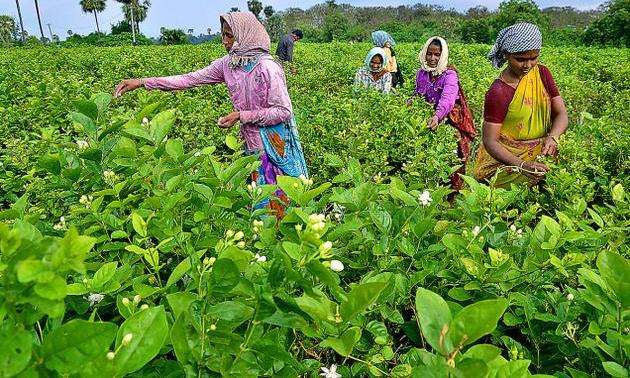
Introduction to Jasmines:
Jasmine is one of the oldest and best fragrant flowers grown. The jasmine flower is used for many purposes i.e, in a bouquet, decorating the hair of women, making garlands, religious offering. Jasmine also used in the production of perfumes and cosmetics. More than 50 types of jasmine species are grown in India, but only three species are used for commercial farming.
- Jasminum sambac(/ Madurai Malli/Gundumalli).
- Grandiflorum(Jathimalli / Pitchi).
- auriculatum(Mullai).
The first one and last species are mainly cultivated for selling as fresh flowers whereas the middle type is cultivated for concrete extraction.
Tamil Nadu holds the no.1 position in producing of jasmine in India. The flowers produced in Tamil Nadu exported to the other countries like Sri Lanka, Malaysia, Singapore, and Middle East countries. The major districts in Tamil Nadu that produces jasmine are Salem, Trichy, Tirunelveli, Dindigul, Madurai, Virudhunagar. Since the jasmine crop requires lots of manpower for harvesting and other operations, only small farmers are interested to cultivate the crop. Jasmine farming It is an ideal crop for small farmers where the land is in small extent (less than 2 acres).
Commercial Verities of Jasmines in India:
The following are major varieties of jasmine commercial crops.
- Gundumalli (Jasminum sambac),
- Co-1 and Co-2 ( Grandiflorum).
- Co-1 and Co-2 ( Auriculatum).
The climatic condition required for Jasmine Plantation:
Jasmine thrives very well in well-drained, sandy loam soils which are rich in organic matter. The ideal agro-climatic conditions for successful jasmine cultivation are warm summer with ample water supply and sunny days with humid conditions.
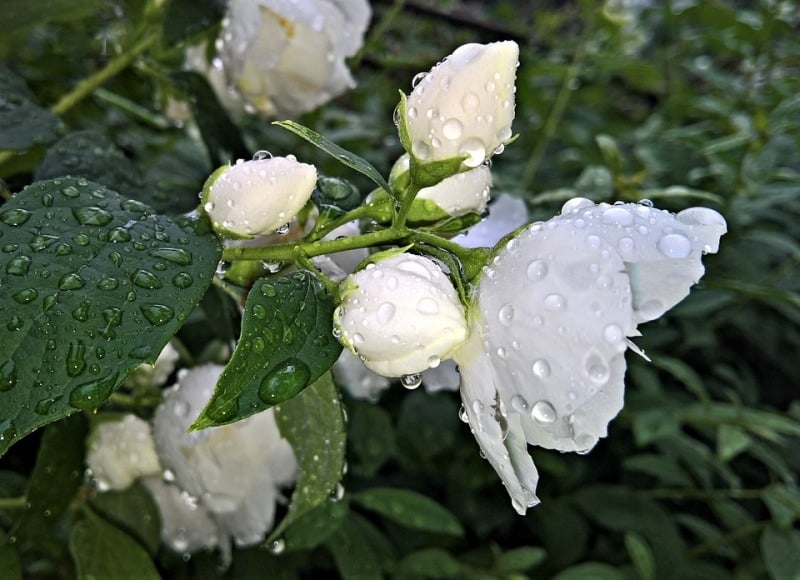
Suitable Soil for Jasmine Plantation:
Jasmine can be grown in a wide range of soils i.e., from clay soils to sandy loam soils with good drainage. For better production make sure the soil is rich by adding organic compost or any Farm Yard Manure (FMY).
Soil Preparation and Planting of Jasmine:
To control or remove the weeds, one or two initial ploughings are required in the main field, which is followed by digging of pits at a size of 30 cm by 30 cm by 30 cm. Add 10 to 12 kg of FYM to each pit before filling the pits. Best season for jasmine plantation is June-November at a spacing of 1.5 m x 1.5 m is ideal.
Manure and Fertilizers for Growing of Jasmines
It is recommended that each plant should be applied with 10 to 12 kg of Farm Yard Manure (FYM) and 120 g each of Phosphorus and Potassium and 60 g of Nitrogen. This should be applied in two split doses once after annual pruning and again during the June to July season.
Water Requirement for Jasmine Plants:
First irrigation should be given immediately after plantation of jasmine and next to water supply should be given at an interval of 5 to10 days depending upon the weather conditions and soil type. If it’s rainy season irrigation may not be required but soil drainage is very important.
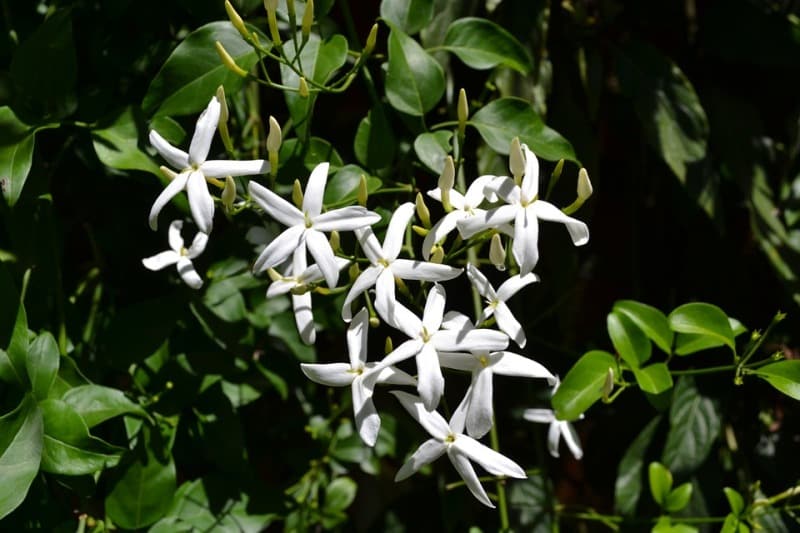
Inter-Cultural Operations and Pruning of Jasmine Crop:
In Jasmine cultivation weeding and strengthening of irrigation channels and bunds should be carried out as part of intercultural operations. The first weeding should be done 3 to 4 weeks after planting the jasmine and subsequent weedings should be once in 2 to 3 months. Training is basically done for giving the desired shape to the jasmine plant whereas, pruning is done to achieve the desired crop production. Usually, water supply is withheld prior to pruning and plants are pruned by removing all past season shoots including dead and diseased branches of jasmine. It is preferred to prune the plants during the last week of November to get better yield and quality of flowers.
Pests and Diseases of Jasmine Plants:
Main Pests in Jasmine plantation are; blossom midge, budworm, and red spider mite. Applying of monocrotophos 36 WSC @ 2ml /l is recommended to control and manage budworm and blossom midge. To control the red spider mite, application of sulfur (50% WP) @ 2g / l is recommended. Nematode and root rot are the major diseases in jasmine farming. To control the Nematode – 10 g of Temic granules/plant near root zone should be applied and for Root rot: Soil drench should be done around the plant with copper oxychloride @ 2.5 g / l.
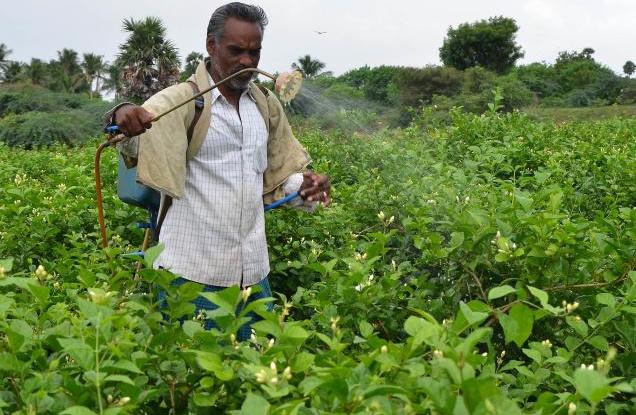
Time of flowering and Harvesting of Jasmine:
Jasmine starts flowering after 6 months of planting. Harvesting to be carried out by picking fully developed unopened flower buds in the early morning.
The yield of Jasmine Flowers:
Below is the yielding chart of Jasmines
| Year | 1 | 2 | 3 | 4 |
| Yield in kg/acre | 800 | 1,600 | 2,600 | 3,600 |
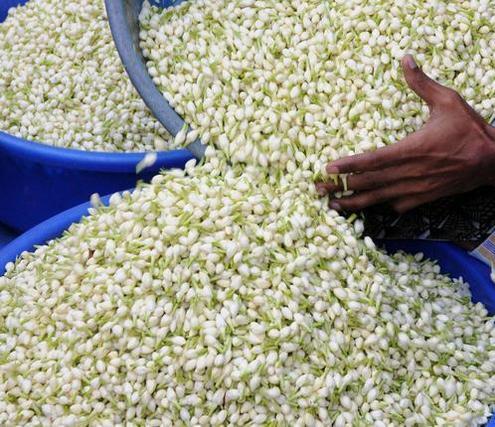
Marketing of Jasmine Flowers:
Lot’s of demand for Jasmine flowers in local markets. You no need to worry about marketing, you can sell them off easily at your farm gate. There are many flower agents in India, who can buy in bulk.
The bottom line of Growing Jasmines:
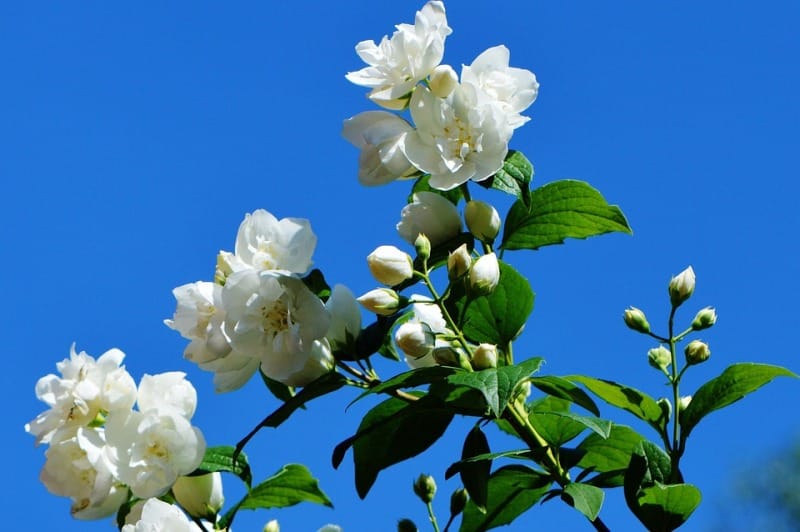
Jasmine production is as great as the way jasmine smells. You can expect great profits in Jasmine farming
Some flowers may be grown using the Hydroponic system, you may find information at Hydroponic Flowers List.
Kindly send a project report on Jasmine farming per acre
Hi We will update soon.
let me know about Jsmine sampac farming.
how long dose it take to flower after pruning. how many months dose jasmine sambac flower in a year
HI, please send a project report on jasmine farming including financial reports as well.
We will update about Jasmine Farming Project Report very soon. Stay tuned!.
Please update project report jasmine flowers.
We will update soon, please check back.
Where will I get jasmine Sambac plants?
Hello Sir,
Appreciate if you could send me Jasmine farming project paper
Hi, can you please provide me the Project Report on Jasmine Farming Including Financial Reports as well.
We need some help to control very small pest
it’s a new pest in jasmine
Send me your whatsapp number or email
I will send the picture &video of new pest
Sir,
Awaiting for reply
I need project report of jasmine flower for 2 acers profits in a year pls mail me